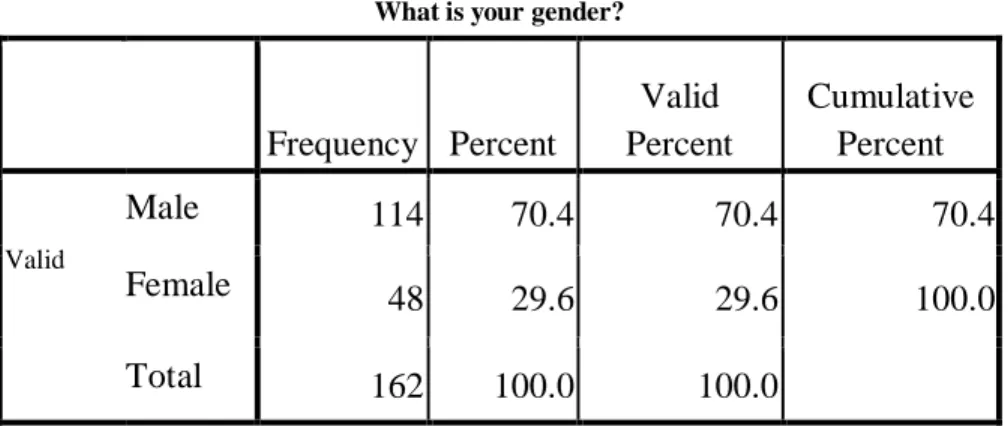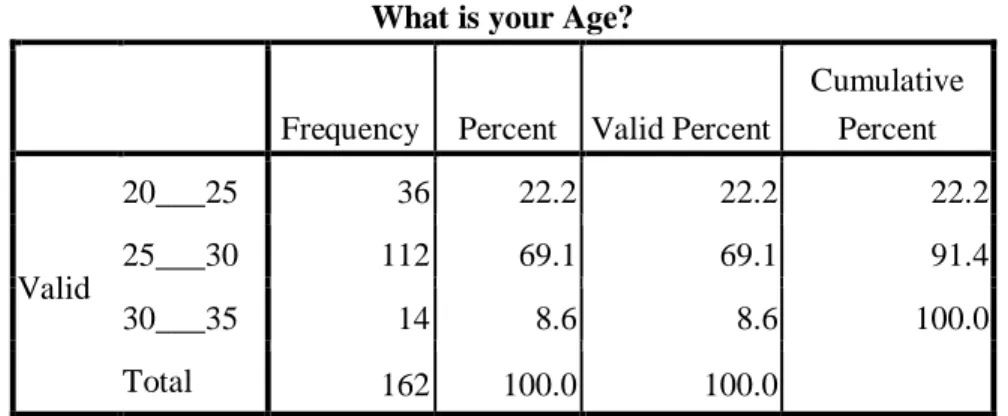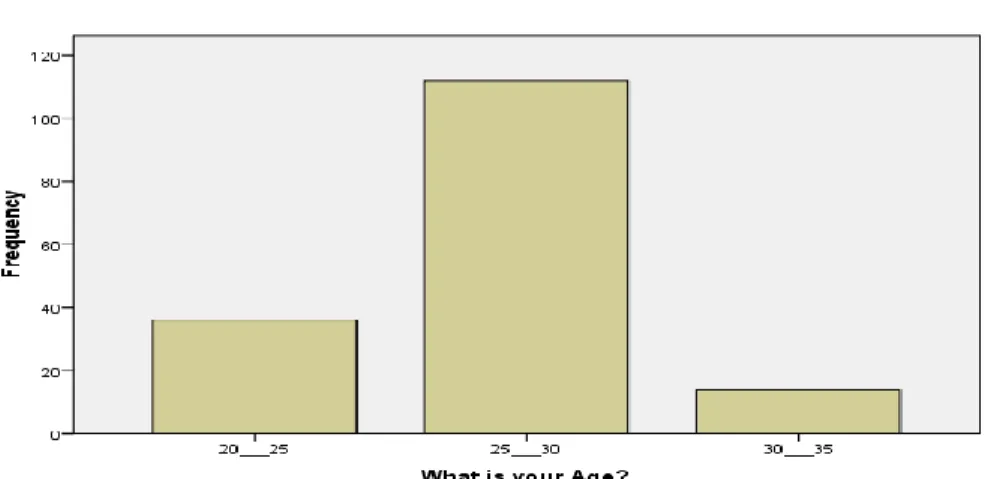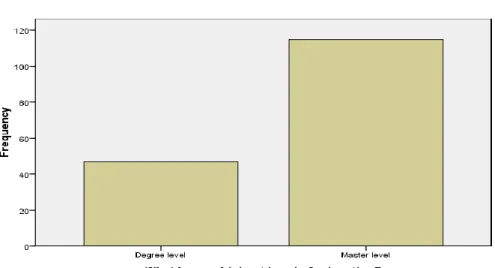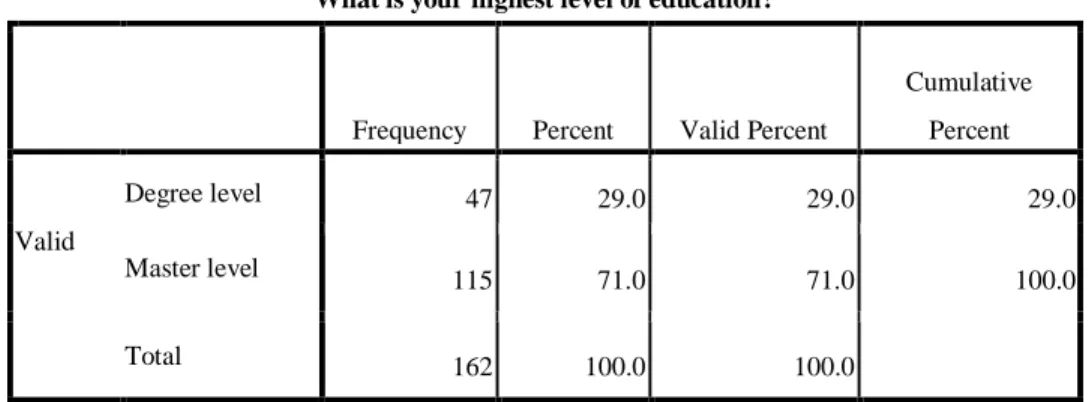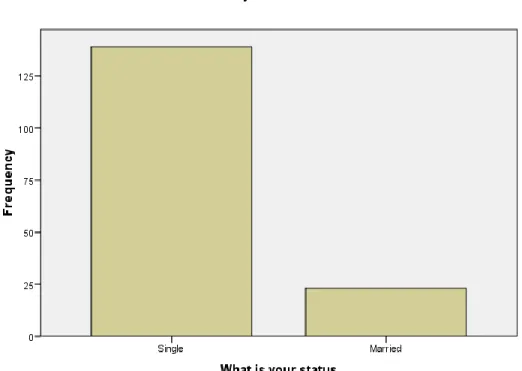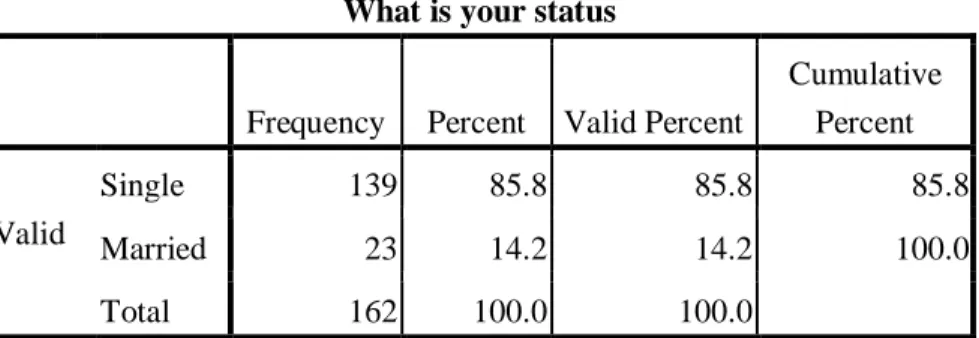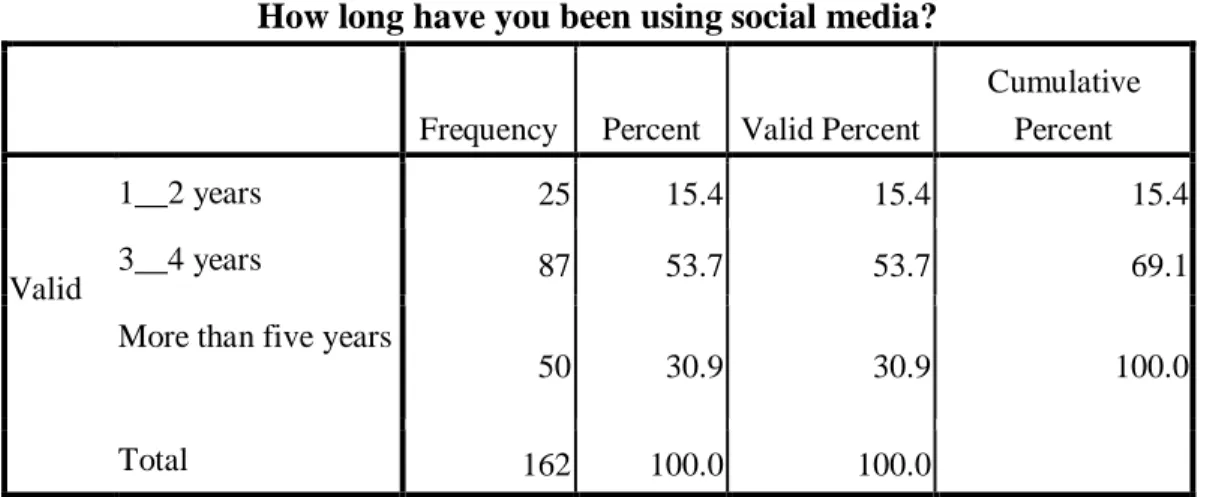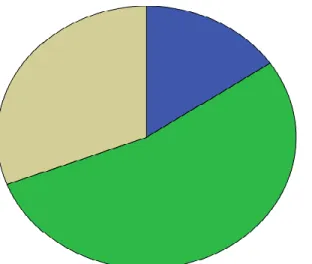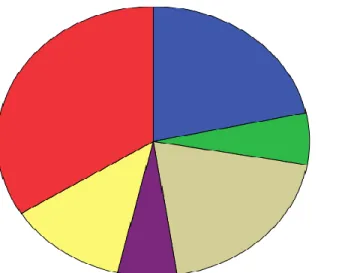Influence of Social Media Use on Academic Performance Among DIU Students
BY
Abdiqani Aden Ahmed ID: 183-25-695
This Report Presented in Partial Fulfillment of the Requirements for the Degree of Master Science in Computer Science and Engineering
Supervised By
Shah Md. Tanvir Siddiquee Assistant professor
Department of Computer Science and Engineering Daffodil International University
DAFFODIL INTERNATIONAL UNIVERSITY DHAKA, BANGLADESH
SEPTEMBER 2019
©Daffodil International University i
© Daffodil International university ii
© Daffodil International university iii
ACKNOWLEDGEMENT
First my thanks are Allah for giving me the health, time, and Knowlagent that I completed my thesis book in master’s degree.
I would like to thank my dear supervisor lecturer Shah Md. Tanvir Siddique for the encouragement and advice about my thesis I have been extremely lucky to have a supervisor who cared so march about my work and who responded to my question and querier so promptly. I would like to thank all the members of staff at daffodil International University.
And also, I will thank my family special my dear parents for their love and supports throughout my life thank you both for giving me strength to reach for the stars and chase my dreams.
And thanks, my dear wife because she is part of my life and she also supports to develop my life and I say, “thanks my dear wife”.
To all my friends thank you for your understanding and encouragement in many moments of crisis your friendship makes my life a wonderful experience I cannot list all the names here, but you are always on my mind.
© Daffodil International university iv
DEDICATION
I want to express my deep gratitude to all who have contributed to this level, especially my parents, my wife and my daughter.
First, I gratitude to my parents: Khadra Abdullahi Mohamed and Dr Aden Ahmed Dahir for your support, encouragement, endless love, pray, everything you have done since I was born.
Secondly my dear wife Hoda Siad Hussein I thank your support, sacrifice and taking care of my life and also thank my little daughter Salma and I will say thanks baba and I wish you long and happy full life.
Finally thank you all to my family because they participate all my life
© Daffodil International university v
ABSTRACT
Social media is started when people start to communicate. Social means human society, as interference of people in groups and word is the medium of expressions. Most of the forms of Social Media are not digital. It generates many innovations and Social Media is one of the biggest inventions of technology, which is now most popular and widely used. We define Social Media as “technologies that made social communication easy and enable discussions among its participants”. While in our study, the word Social Media means a web-based mobile application that allows people or companies to make, interact with, and share new user-generated or current material, in digital environment.
Today, it is crucial to determine the impact of social media on the academic performance of students. Technology is booming rapidly from year to year, and the younger generations are the ones caught in this rapid change. Questionnaires were distributed through Facebook and E-mails, to find out whether students’ academic performance is impacted by social media or not. The findings demonstrate that there is no relationship between social media and academic performance; this is clearly projected in their overall grade average.
© Daffodil International university vi
TABLE CONTENTS
APPROVAL ... iError! Bookmark not defined.
DECLARATION ... ii
ACKNOWLEDGEMENT ...iiii
DEDACTION ... iv
ABSTRACT ... v
TABLE CONTENTS... vi
LIST OF FIGURES... viii
LIST OF TABLES ... ix
CHAPTER 1: INTRODUCTION ... 1
1.1 Introduction ... 1
1.2 Motivation ... 3
1.3 Rational of Study ... 3
1.4 Research Questions ... 3
1.5 Expected Output ... 3
1.6 Report Layout ... 4
CHAPTER 2: BACKGROUND... 5
2.1 Introduction ... 5
2.2 Related Works ... 5
2.3 Research Summery ... 6
2.4 Scope of the Problem ... 7
2.5 Challenges ... 7
CHAPTER 3: RESEARCH METHODOLOGY ... 8
3.1 Introduction ... 8
3.2 Research Subject and Instrumentation ... 8
3.3 Data Collection Procedure ... 8
3.4 Statistical Analysis ... 8
3.5 Reliability and Validity... 9
CHAPTER 4: EXPERIMENTAL RESULTS AND DISCUSSION ... 10
© Daffodil International university vii
4.1 Introduction ... 10
4.2 Experimental Results ... 10
4.3 Descriptive Analysis... 10
4.4 Summery ... 29
CHAPTER 5: SUMMARY, CONCLUSION, RECOMMENDATION ... 30
5.1 Introduction ... 30
5.2 Summary of the Study ... 30
5.3 Conclusion ... 31
5.4 Recommendation ... 31
5.5 Implication for further study ... 32
References ... 33
Appendix ... 34
© Daffodil International university viii
LIST OF FIGURES
Figure 4.1 Gender respondents ... 11
Figure 4.2 Age respondents... 12
Figure 4.3 Educational level respondents ... 13
Figure 4.4 Marital Status ... 14
Figure 4.5 How long have you been using social media? ... 15
Figure 4.6 Which one do you use most of your time ... 16
Figure 4.7 How many hours in a day you spend on social media? ... 17
Figure 4.8 What are your uses for social media?... 18
Figure 4.9 Do you think social media effect your academic performance negatively respondents... 19
Figure 4.10 Do you think the google class-rooms are important in academic performance ... 20
Figure 4.11 Can social media effect your future negatively. ... 21
Figure 4.12 Why do you use social media ... 22
Figure 4.13 Do you think the social media is the best way for teachers to reach their students ... 23
Figure 4.14 Student and lecturers can share information using social media ... 24
Figure 4.15 Which people you communicate mostly in social media ... 25
Figure 4.16 Do social media can cause miss your classes ... 26
Figure 4.17 Do you think social media is important for upcoming generation ... 27
Figure 4.18 Do you have more friends on social media as compared to real life? ... 28
© Daffodil International university ix
LIST OF TABLE
Table 4.1 Gender response ... 11
Table 4.2 Age response... 12
Table 4.3 Education level response ... 13
Table 4.4 Education level response respondents ... 14
Table 4.5 Time the respondents they are using social media respondents ... 15
Table 4.6 Which one is the most used respondents ... 16
Table 4.5 Social media use per day respondents? ... 17
Table 4.8 What are your uses for social media respondents? ... 18
Table 4.9 Social media effect on academic performance respondents? ... 19
Table 4.10 Do you think the google class-rooms are important respondents? ... 20
Table 4.11 Can social media effect your future negatively respondents? ... 21
Table 4.12 Why do you use social media respondents ... 22
Table 4.13 Do you think the social media is the best way for teachers to reach their students respondent? ... 23
Table 4.14 Students and lectures can share information using social media respondents? ... 24
Table 4.15 Which people you communicate mostly in social media respondents?... 25
Table 4.16 Do social media can cause to miss your classes respondents?... 26
Table 4.17 Do think social media is important for upcoming generations respondents? ... 27
Table 4.18 Do you have more friends on social media as compared to real life respondents? ... 28
© Daffodil International university 1
CHAPTER 1 INTRODUCTION
1.1 Introduction
The social media has become one of the most important communication means in current times the social media is a tool that people is used to sharing information from the different places the social media has become most important communication of people social media it can be do sharing files, photos, videos, and information for easy way.
Social media has been a good way of communication since the 1990s. Social media is an easy way of communication through which individuals make, share information and opinions. Social media has brought the world closer than ever before. The improvement of technology has lowered down the problems of communication. The social media sites are used all around the world. Social media became the best option for individuals to give out information, work together regardless of where they live (Ugwulebo and Okoro, 2016). (1) Social media has increased the connectedness of people. There are numerous social networking sites used like Twitter, Facebook, messenger, what’s app messenger, imo for videos and calls, 2go messenger, Google talk, Google messenger, and google accounts (Asemahand & Edegoh, 2012) (2).
When we talked about the social media the important thing is social media history such as when the social media is started?
What is the social media growth levels? And how is to day?
When we are talking about history of social media there are two kind of social media developed since the end of the 19th century six degrees and Friendster after many years the social media it has been a lot of progress and made a lot of new apps like Facebook, what’s app, Instagram, snapchat and twitter (3).
Within a few last years, social media has become increasingly moving day after day and with high speeds and Many companies have introduced new apps to connect with the community such as Facebook, Instagram, twitter, snapchat and more then Now we want to know about the history of the program we mentioned above.
© Daffodil International university 2 Facebook: the Facebook application was developed on February 4.2004 by mark Zuckerberg the Facebook allowed the users to share information, videos, audio, photos and more other activities. (4).
What’s app: was developed on 2009 by Brian Acton and Jan Koum they were employees of Yahoo what’s app is allowed the users the share information in text, audio, video, and images. (5)
Instagram: was developed on October 6, 2010 by kevin systrom and mike Krieger Instagram allowed the users to share information in text, audio, videos, and photos like what’s app and Facebook. (6)
Snapchat: was founded on September 2011 by Evan Spiegel, Bobby Murphy and Reggie Brown this application is allowed the users to share information like text, videos, and images mostly snapchat used share videos. (7)
Twitter: was developed on March 21, 2006 by Jack Dorsey, Noah glass, Biz Stone, and Evan Williams this application mostly use the politicians. (8)
Academic achievements are very important to students’ future success, getting a good job, for these reason students are always concerned with how they can enhance their academic achievements. Obtaining academic performance is very much liked all over the world that is why studies focused on ways to of obtaining it. Academic achievement influences the student’s life success, academic placement in schools to higher institutions and their chances of employment. (Kyoshaba, 2009).
Today Bangladeshi universities have attracted and become the knowledge destination for many international students. The universities provide the students with the basic facilities required for their education.
Daffodil international university is a private and among the top ten universities in Bangladesh. DIU is the number one university admitted the international university the DIU university provides students basically needed facilities for education such as modern library, large campuses and good environment for studies and Wi-Fi connectivity where students can connect to the networking sites and benefit for their educational purposes.
© Daffodil International university 3 1.2 Motivation
Nowadays using of social media has become part of regular life and has the important way of sharing information all the world the social media affected everything such as the politics, jobs, associations and education and the students they are victims of
That issues.
After I realized the effect social media of education and students I decided to write something about the influence of social media on students, so, that is why I preferred to talk about this topic and I can’t complete here all of the relation things about this topic, but I will try to make some research about depression.
1.3 Rational of Study
The research of this topic is to reliable data of influence of social media on academic performance in student atDaffodil International University in Bangladeshi. To address the study excellently students in Daffodil international University were measured.
Following are the specific objectives of this research
To find the impact of social media on academic performance of DIU students To compare schedule time of used social media and prepared of university lessons To identify the reasons for using social media on student of DIU
1.4 Research Questions The research questions will be
1. What is the effect of social media on academic performance in DIU students?
2. What are the reasons that students are using social media on long time ever day?
3. How long does the students lose access to the social media?
1.5 Expected Output
This proposal will be helping the student on DIU and other student in Bangladesh and all over the word to know the influence on social media in their education and development and also, they will recognize their missing time on using social media unconsciously.
I hope this research will be help the teachers to know about the impact of social media in their students so as to help them to reform the student and displaying data on the influence of social media on students.
© Daffodil International university 4
1.6 Report Layout
Report layout we will discourse about the following Chapters
Chapter one: we talk in chapter one about introduction influence on social media in academic performance, Motivation of the research, Rationale of the study, Expected Outcome, and Report Layout.
Chapter two: we will discuss chapter two Introduction, Related Works, Research summary, Scope of the Problem and Challenges.
Chapter three: in chapter three we will discuss introduction of research methodology, research subject and instrumentation, procedure of data collection, statistical analysis, and implementation requirements.
Chapter four: we will discuss in this chapter experimental result and discussion this chapter will be discuss introduction, experimental results, descriptive analysis and summary.
Chapter five: this chapter is summary and conclusion this chapter will be discuss summary of the study, conclusions, recommendations, and implication for further study.
© Daffodil International university 5
CHAPTER 2
BACKGROUND
2.1 Introduction
In this chapter I will be discuss related work and literature review about the influence of social media on academic performance among the DIU students the literature review will show us the importance of this topic and we will present previous research’s and articles of this topic.
This chapter I will cover research summery, problem scope and challenges. 2.2 Related Works
Social media is one of the more interesting as a topic of research in the field of social science. Researchers from different backgrounds started to reflect the different features of social media. Most important issues have been focusing on how social media impacts on the students in terms of their academic performance.
Numerous research studies have been directed across the world investigative the influence of social media on the academic performances of students.
2.2.1 Social Media
The social media is applications that connect the people to share more information the Different academic has defined it in a various way Jacka and Scott (2011, may) say ““there is no single recognized definition of social media”. drury (2008, January) (3) defines the social media “Online incomes that people use to share information such as: images, photos, video, text and news “Safko and Brake (2008)(4) extra defined the social media as
“activities, practices, and behaviors among groups of people who gather online to share information, knowledge, and opinions using conversational media. Predictable media are web-based application that make possible for one to create and easily communicate content in the form of text, picture, audios and videos”. different professors described their proposals about the social media, and they support Drury’s definition and explains the role of social media in an accurate statement. that social network has become a global platform where sharing date commonly
© Daffodil International university 6 2.2.2 Academic performance
Academic performance is related in this proposal it’s the main point that helps students to achieve in their academic goals.
When we are talking about academic performance in university level its focused students’
exams and their grades or GPA in other side academic performance it’s to find out the student’s behavior with the community (5).
So, when we know about the academic performance our objectives are to investigates the impact of social media in the student’s performance in DIU students.
2.2.3 Social Media and Academic Performance
For many years education has been complaining about influence of the social media in academic students and their performance this influence may be negative or positive There are many things that can cause the effect of social media on academic performance such as addiction of social media The usage of social media in academic performance same times it’s a positive effect such as sharing information and knowledge between students they communicate with their family and friends. it’s also includes positive effects they learned online course in their homes social media sites can be used create to build a good relationship between lectures and students as lectures send and share the reading material to their students through online sites. Social media sites give good opportunities that students can create groups or google class-room where they can discuss issues about in their classrooms (6). On the other hand, using of social media in academic performance it has a negative effect for example Addiction to social media when the people who addicted to social media, they will have negative attitudes such as eye strain social withdrawal or lock of sleep, stress. same times students they spend more time using social media and they are not having enough time to read their lessons and prepared their assignments, and exams (7)
2.3 Research Summery
The summery of research will be define the impacts of social media on academic performance in DIU students and will be present the important data and research about the impact of social media in DIU student.
While research, focused the impact of social media in students, influence the social media on academic performance and reliable data In DIU students and social media.
The data we will present in this research will be mostly primary data and same times will use secondary data to get accurate data.
© Daffodil International university 7 2.4 Scope of the Problem
The problem scope in this research may be a general problem it can affect everyone, so we are talking about the students and education what is affecting the students is affected by the whole community because the students are the future of the world.
The social media is a tool that affect every student in the world same student’s social media affected positively and they benefit from their development, but most students affected negatively, and they spend all the time using on social media so that this topic is very important to make more proposals and research’s.
May research area is Daffodil Intentional University in Bangladesh.
2.5 Challenges
The social media have more challenges on academic performance in students such as lass reading time for student sometimes the student went to read or prepared something when he turns on his computer automatically connect internet and same of his friends are in online and he is chatting and spend the time of reading.
The social media and long-time usage internet it can causes the health damage because it can cause lock sleep and eye strain.
© Daffodil International university 8
CHAPTER 3
RESEARCH METHODOLOGY 3.1 Introduction
In this chapter will discuss the research methodology of influence in social media on academic performance among DIU students and, we will be talking research subject and instrumentation
We will also identity the data collection procedure and how we analysis and presentation the data
Finally, we will explain the implementation requirements.
3.2 Research Subject and Instrumentation
The research instrument we use is questionnaire that we collect data in DIU students, and we ask more important questions the influence of social media in their academic performance and effect in their education situation.
This questionnaire must be related and present the research objectives, to achieve these ends we need to make same decisions:
✓ How to ask?
✓ How each question can solve?
✓ What is the classification should the questions be organized?
✓ What kind of questionnaire design will best help the researcher purposes?
✓ Does the questionnaire need to review?
3.3 Data Collection Procedure
Data collection procedure is the process of gathering information on variables of interests and answer research questions and evaluate outcomes collection of data is importance of the research the structure of data depends the type of tools that researchesused to collected essential data.
In our research the data collection procedure is a questionnaire the questionnaire contains number of questions about the students every one of the sample papulation required to read and understand the questions and write down the actual answer of that questions.
3.4 Statistical Analysis
The statistical analysis of this research will be (SPSS) the SPSS program will be used to data entry and analysis to present the result of questionnaire and research output.
© Daffodil International university 9 3.5 Reliability and Validity
The reliability and validity are instruments that researchers are used to measure the validity and reliability appropriateness and consistency of the instruments used to the researcher.
Study is repeated under the same conditions validity and reliability thus measures the extent to which there may be an error in measurements.
© Daffodil International university 10
CHAPTER 4
EXPERIMENTAL RESULTS AND DISCUSSION
4.1 Introduction
The chapter four is about the analyzing data of the research questionnaire the data analysis based on research purposes Presentation and analysis of the collected data was computed using the frequency and percentages
4.2 Experimental Results
The experimental results in our research will be tables and graphs were used in the presentation and explain of data the respondent has same questionnaire about the research topic sample size of study population was 160 while the target population is 200.
4.3 Descriptive Analysis
Descriptive statistics are used to describe the basic features of the data in a study. They provide simple summaries about the sample and the measures. Together with simple graphics analysis, they form the basis of virtually every quantitative analysis of data.
© Daffodil International university 11 4.3.1 Gender Response
Table 4.1 Gender response
What is your gender?
Frequency Percent
Valid Percent
Cumulative Percent
Valid
Male 114 70.4 70.4 70.4
Female 48 29.6 29.6 100.0
Total 162 100.0 100.0
The table 4.1 shows 114 (70.4%) respondents are male and 48(29.6%) respondents are female most of the respondents are male.
The following figure 4.1 shows table 4.1 graph.
Figure 4.1 gender respondents
© Daffodil International university 12 4.3.2 Age Response
Table 4.2 Age response
The table 4.2 shows 36(22.2%) of the respondents are at the age between 20 – 25
And 112(69.1%) are at the age between 25 – 30 this group are the most respondent in the questionnaire about the age the last group are at the age between 30 – 35 the quantity of this group 14(8.6%)
The following figure 4.2 shows table 4.2 graph
Figure 4.2 age respondents What is your Age?
Frequency Percent Valid Percent
Cumulative Percent
Valid
20___25 36 22.2 22.2 22.2
25___30 112 69.1 69.1 91.4
30___35 14 8.6 8.6 100.0
Total 162 100.0 100.0
© Daffodil International university 13 4.3.3 Education level Response
Table 4.3 Education level response
What is your highest level of education?
Frequency Percent Valid Percent
Cumulative Percent
Valid
Degree level 47 29.0 29.0 29.0
Master level
115 71.0 71.0 100.0
Total 162 100.0 100.0
The table 4.3 shows the education level of respondents 47(29.0%) are degree level most respondents are master level 115(71.0%)
The following figure 4.3 shows the graph of table 4.3
Figure 4.3 educational level respondents
© Daffodil International university 14 4.3.4 Marital Status Response
Table 4.4 Education level response respondents
What is your status
Frequency Percent Valid Percent
Cumulative Percent Valid
Single 139 85.8 85.8 85.8
Married 23 14.2 14.2 100.0
Total 162 100.0 100.0
This table 4.4 shows the marital status of the respondents were 139(85.2%) single the percentage show most of respondent are single 23(13.6%) married.
The following figure 4.4 show graph of table 4.4
Figure 4.4 Marital Status
© Daffodil International university 15 4.3.5 How long have you been using social media Response
Table 4.5 time the respondents they are using social media respondents How long have you been using social media?
Frequency Percent Valid Percent
Cumulative Percent
Valid
1__2 years 25 15.4 15.4 15.4
3__4 years 87 53.7 53.7 69.1
More than five years
50 30.9 30.9 100.0
Total 162 100.0 100.0
The table 4.4 shows the time that respondents are using social media 1 – 2 years 25(15.4%) they are using social media the second group they are using 3 – 4 years 87(53.7%) this data shows the most of respondents they are using 3 up to 4 yeas the last group they are using more than 5 years 50(30.9%)
Figure 4.5 How long have you been using social media?
© Daffodil International university 16 4.3.6 Which one do you use most of your time Response?
Table 4.6 which one is the most used respondents
Which one do you use most of your time?
Frequency Percent Valid Percent
Cumulative Percent
Valid
Facebook 35 21.6 21.6 21.6
Twitter 10 6.2 6.2 27.8
Instagram 32 19.8 19.8 47.5
WhatsApp 10 6.2 6.2 53.7
YouTube 20 12.3 12.3 66.0
All 55 34.0 34.0 100.0
Total 162 100.0 100.0
The table 4.6 shows the 35(21.6%) most social media use is Facebook 10(6.2%) most social media use is twitter 32(19.8%) most social media use is Instagram 10(6.2%) most social media use is WhatsApp 20(12.3%) most social media use is YouTube 55(34.0%) this group they most use all social media the fallowing figure 4.6 shows the graph of table 4.6
Figure 4.6 which one do you use most of your time
© Daffodil International university 17
4.3.7 How many hours in a day you spend on social media Response Table 4.5 social media use per day respondents?
How many hours in a day you spend on social media?
Frequency Percent Valid Percent
Cumulative Percent
Valid
1 hour 11 6.8 6.8 6.8
2___4 hours 78 48.1 48.1 54.9
5___6 hours 45 27.8 27.8 82.7
More than 7 hours 28 17.3 17.3 100.0
Total 162 100.0 100.0
The above of the table 4.7 we know how many hours our respondents they are spend using on social media as you can see this table they are deferent groups the first one they are spend 1 hours per day 11(6.8%) the second group they are spend 2 – 4 hours per day 78(48.1%) the third group they are spend 5 – 6 hours per day 45(27.8%) the last group they are spend on social media per day more than 7 hours 28(17.3%) the figure 4. shows table 4.7 data graph
Figure 4.7 how many hours in a day you spend on social media?
© Daffodil International university 18 4.3.8 What are your uses for social media Response?
Table 4.8 What are your uses for social media respondents?
What are your uses for social media?
Frequency Percent Valid Percent
Cumulative Percent
Valid
Social 53 32.7 32.7 32.7
Academic 77 47.5 47.5 80.2
Movies 18 11.1 11.1 91.4
Games 3 1.9 1.9 93.2
Others 11 6.8 6.8 100.0
Total 162 100.0 100.0
The above of the table 4.8 show what the reason that respondents are using on social media 53(32.7%) they use social 77(47.5%) they use academic 18(11.1%) they use to watch movies 3(1.9%) they play games 11(6.8%) they use other objectives the fallowing figure 4.8 shows data with graph
Figure 4.8 What are your uses for social media?
© Daffodil International university 19 4.3.9 Do think social media effect your academic performance negatively Response?
Table 4.9 social media effect on academic performance respondents?
Do you think social media effect your academic performance negatively?
Frequency Percent Valid Percent
Cumulative Percent
Valid
Strongly agree 29 17.9 17.9 17.9
Agree 101 62.3 62.3 80.2
Neutral 4 2.5 2.5 82.7
Disagree 26 16.0 16.0 98.8
Strongly disagree 2 1.2 1.2 100.0
Total 162 100.0 100.0
The table 4.9 shows what the respondent believes about the effect of social media on academic performance 29(17.9%) strongly agree 101(62.3%) Agree 4(2.5%) neutral 26(16.0%) disagree the last 2(1.2%) strongly disagree
The figure 4.9 shows data graph
Figure 4.9 Do you think social media effect your academic performance negatively respondents
© Daffodil International university 20 4.3.10 Do think the google class-rooms are important in academic performance Respondents
Table 4.10 Do you think the google class-rooms are important respondents?
Do you think the google class-rooms are important in academic performance?
Frequency Percent Valid Percent
Cumulative Percent
Valid
Strongly agree 27 16.7 16.7 16.7
Agree 114 70.4 70.4 87.0
Neutral 9 5.6 5.6 92.6
Disagree 12 7.4 7.4 100.0
Total 162 100.0 100.0
The above table 4.10 shows 27(16.7%) strongly agree 144(70.4%) Agree 9(5.6%) neutral 12(7.4%) disagree.
The fallowing figure 4.10 shows graphs of table
Figure 4.10 do you think the google class-rooms are important in academic performance
© Daffodil International university 21 4.3.11 Can social media effect your future negatively Respondents
Table 4.11 can social media effect your future negatively respondents?
Can social media effect your future negatively?
Frequency Percent Valid Percent
Cumulative Percent
Valid
Strongly agree 20 12.3 12.3 12.3
Agree 90 55.6 55.6 67.9
Neutral 13 8.0 8.0 75.9
Disagree 36 22.2 22.2 98.1
Strongly disagree 3 1.9 1.9 100.0
Total 162 100.0 100.0
The above table 4.11 shows the result of this question 20(12.3%) strongly agree 90(55.6%) agree 13(8.0%) neutral 36(22.2%) disagree 3(1.9%) strongly disagree.
The following figure 4.11 shows graph of table 4.11
Figure 4.11 can social media effect your future negatively.
© Daffodil International university 22 4.3.12 Why do you use social media Respondents
Table 4.12 why do you use social media respondents Why do you use social media?
Frequency Percent Valid Percent
Cumulative Percent
Valid
To fill up spare time 18 11.1 11.1 11.1
To meet new people 66 40.7 40.7 51.9
To stay in touch with what friends and family doing
49 30.2 30.2 82.1
General networking with
other people 9 5.6 5.6 87.7
Other stuff 20 12.3 12.3 100.0
Total 162 100.0 100.0
The above of the table 4.12 shows the responds of why you use social media 18(11.1%) to fill up spare time 66(40.7%) to meet new people 49(30.2%) to stay in touch with what friends and family doing 9(5.6%) general networking with other people 20(12.3%) they use other objectives the figure 4.12 shows table 4.12 graph
Figure 4.12 why do you use social media
© Daffodil International university 23 4.3.13 Do you think the social media is the best way for teachers to reach their
students Respondents
Table 4.13 Do you think the social media is the best way for teachers to reach their students respondent?
Do you think the social media is the best way for teachers to reach their students?
Frequency Percent Valid Percent
Cumulative Percent
Valid
Strongly agree 41 25.3 25.3 25.3
Agree 89 54.9 54.9 80.2
Neutral 19 11.7 11.7 92.0
Disagree 13 8.0 8.0 100.0
Total 162 100.0 100.0
The above of the table 4.13 shows 41(25.3%) strongly agree 89(54.9%) agree 19(11.7%) neutral 13(8.0%) disagree the following figure 4.13 show the graph of the table 4.13.
Figure 4.13 do you think the social media is the best way for teachers to reach their students
© Daffodil International university 24 4.3.14 Students and lectures can share information using social media Respondents Table 4.14 Students and lectures can share information using social media respondents?
Students and lecturers can share information using social media?
Frequency Percent Valid Percent
Cumulative Percent
Valid
Excellent 48 29.6 29.6 29.6
Good 102 63.0 63.0 92.6
Average 10 6.2 6.2 98.8
Poor 2 1.2 1.2 100.0
Total 162 100.0 100.0
The above table 4.14 shows 48(29.6%) excellent 102(63.0%) good 10(6.2%) average 2(1.2%) poor
The figure 4.14 show the graph
Figure 4.14 student and lecturers can share information using social media
© Daffodil International university 25 4.3.15 Which people you communicate mostly in social media Respondents?
Table 4.15 which people you communicate mostly in social media respondents?
Which people you communicate mostly in social media?
Frequency Percent Valid Percent
Cumulative Percent
Valid
Family 76 46.9 46.9 46.9
Friends 61 37.7 37.7 84.6
Others 25 15.4 15.4 100.0
Total 162 100.0 100.0
The above table 4.15 shows the respond of which you communicate mostly in social media 76(46.9%) family 61(37.7%) friends 25(15%) others.
The fallowing figure 4.15 shows graph
Figure 4.15 which people you communicate mostly in social media
© Daffodil International university 26 4.3.16 Do social media can Cause to miss your classes Respondents?
Table 4.16 Do social media can cause to miss your classes respondents?
Do social media can cause to miss your classes?
Frequency Percent Valid Percent
Cumulative Percent
Valid
Yes it happens more often 3 1.9 1.9 1.9
No i never missed any classes due to social media usage
121 74.7 74.7 76.5
Sometimes it happened 28 17.3 17.3 93.8
Can't recall or remember 10 6.2 6.2 100.0
Total 162 100.0 100.0
The table 4.16 shows 3(1.9%) yes it happens more often 121(74.7%) no I never missed any classes due to social media usage 28(17.3%) same times it happened 10(6.2%) can’t recall or remember.
The fallowing figure 4.16 shows the graph
Figure 4.16 do social media can cause miss your classes
© Daffodil International university 27 4.3.17 Do think social media is important for upcoming generations Respondents Table 4.17 Do think social media is important for upcoming generations respondents?
Do you think social media is important for upcoming generations?
Frequency Percent Valid Percent Cumulative Percent
Valid
Yes
138 85.2 85.2 85.2
No
24 14.8 14.8 100.0
Total 162 100.0 100.0
The above table 4.17 shows the respond 138(85.2%) Yes 24(14.8%) No.
The fallowing figure 4.17 shows the graph
Figure 4.17 do you think social media is important for upcoming generation
© Daffodil International university 28 4.3.18 Do you have more friends on social media as compared to real life
Respondents?
Table 4.18 Do you have more friends on social media as compared to real life respondents?
Do you have more friends on social media as compared to real life?
Frequency Percent Valid Percent
Cumulative Percent
Valid
Yes 65 40.1 40.1 40.1
No 97 59.9 59.9 100.0
Total 162 100.0 100.0
The above table 4.18 shows the respond of social media friend as compared real life 65(40.1%) Yes 97(59.9%) No.
The fallowing figure4.18 shows the table 4.18 graph
Figure 4.18 do you have more friends on social media as compared to real life?
© Daffodil International university 29 4.4 Summery
This chapter we discussed result of the study and output of research questionnaire and also, we will explain analysis of experimental results and descriptive analysis I will hope this study will represent important and reliable data in DIU that will help teachers and students to get information about impact of social media around their environment.
© Daffodil International university 30
CHAPTER 5
SUMMARY, CONCLUSION, RECOMMENDATION
5.1 Introduction
Chapter five is the last chapter of my research topic and we will present the finding of questionnaire results. conclusion of the study and recommendation in the first step we will discuss the main and important finding of research questionnaire.
The second point we will discuss about the conclusion of study finally is recommendation of this study and areas upcoming researches.
5.2 Summary of the Study
In this research summery that we will present the output results on our questionnaire and we focused the important finding that we collected
5.2.1 How long have you been using social media Response?
Table 4.5 shows 1 – 2 years 25(15.4%) they are using social media the second group they are using 3 – 4 years 87(53.7%) this data shows the most of respondents they are using 3 up to 4 yeas the last group they are using more than 5 years 50(30.9%).
5.2.2 Which one do you use most of your time Response?
The table 4.6 shows the 35(21.6%) most social media use is Facebook 10(6.2%) most social media use is twitter 32(19.8%) most social media use is Instagram 10(6.2%) most social media use is WhatsApp 20(12.3%) most social media use is YouTube 55(34.0%) this group they most use all social media.
5.2.3 How many hours in a day you spend on social media Response?
The table 4.7 we know how many hours our respondents they are spend using on social media as you can see this table they are deferent groups the first one they are spend 1 hours per day 11(6.8%) the second group they are spend 2 – 4 hours per day 78(48.1%) the third group they are spend 5 – 6 hours per day 45(27.8%) the last group they are spend on social media per day more than 7 hours 28(17.3%).
© Daffodil International university 31 5.2.4 What are your uses for social media Response?
The table 4.8 show what the reason that respondents are using on social media 53(32.7%) they use social 77(47.5%) they use academic 18(11.1%) they use to watch movies 3(1.9%) they play games 11(6.8%) they use other objectives.
5.2.5 Can social media effect your future negatively Respondents?
The above table 4.11 shows the result of this question 20(12.3%) strongly agree 90(55.6%) agree 13(8.0%) neutral 36(22.2%) disagree 3(1.9%) strongly disagree.
5.2.6 Why do you use social media Respondents?
The table 4.12 shows the responds of why you use social media 18(11.1%) to fill up spare time 66(40.7%) to meet new people 49(30.2%) to stay in touch with what friends and family doing 9(5.6%) general networking with other people 20(12.3%) they use other objectives.
5.3 Conclusion
This research revealed or displayed the student’s usage on social media in Daffodil International University and also proved the effect of social media in students and academic performance when I was in the data collection, I focused to get Mach-needed data to get a good output.
5.4 Recommendation
Based on result of this study the following recommendation are mode
1. The university most give more awareness to the students to reduce the amount time using social media
2. Very one most know why do you use on social media? what is advantages and disadvantage in yourself on social media using?
3. You should try to use social media in positively side
4. More be careful the impact of social media in your academic performance and your personality
5. The students should focus on the academic relevance in the internet instead of using them as a negative purpose
© Daffodil International university 32 5.5 Implication for further study
The researcher recommends some further study this research is a way of student to make other researches in this area especially Daffodil International University in a further study this research helps to get support using in this data.
© Daffodil International university 33
References
[1] Ugwulebo Jeremiah Emerks, Okoro Sunday Nyeche in influence of social media on academic performance published on 2016.
[2] Asemahand & Edegoh of impact of social media on 2013
[3] Profiles as conversation: Networked identity performance on Friendster and six degrees Proceedings of Thirty-Ninth Hawai’i International Conference on System Sciences Los Alamitos, in 2016.
[4] Corlson, Nicholas (2010) the full story of how Facebook was founded on (March 5) retrieved November 26. 2015
[5] 2019 Candybit Social | Social Media Management Tools | Social Media Dashboard on (June 2018)
[6] Beltrone, Gabriel (July 29, 2011). Beringer Capital. Retrieved April 12, 2017.
[7] APKMirror. Android Police. April 1, 2018. Retrieved April 1, 2018.
[8] jack Dorsey (oct 14.2015 updated Jun 22.2019) Missouri University of Science and Technology, Bishop DuBourg High School, New York University
[9] Jacka and Scott (2011, may) [10] “Safko and Brake (2008)
[11] Hoyle, E. (1986). Policies of school management. Suffolic: The Press Ltd.
[12] Harrath, Y., &Alobaidy, H. (2016). Impact of social networking sites on student academic performance: The case of university of Bahrain. Journal of Cases on Information Technology (JCIT), 18(2), 35-50.
[13] Jaclyn Cabral (2011) Is Generation Y Addicted to Social Media? The Elon Journal of Undergraduate Research in Communications, 2 (1).5-14 spring 2011.
© Daffodil International university 34
Appendix
Questionnaires
Section A: personal information 1. What is your gender?
a. Male b. Female
2. What is your age?
a. 20 ____25 b. 25 ____30 c. 30 ____35 d. Above 35 years
3. What is your highest level of education?
a. Degree level b. Master level
4. What is your marital status?
a. Single b. Married
Section B: questions related the students and social media usage 5. How long have you been using social media?
a. Under one year b. 1__2 years c. 3__4 years
d. More than five years
6. Which one do you use most of your time?
a. Facebook b. Twitter c. Instagram d. WhatsApp e. YouTube f. Viber g. All
7. How many hours in a day you spend on social media?
a. 1 hour b. 2___4 hours c. 5___6 hours d. More than 7 hours
© Daffodil International university 35 8. What are your uses for social media?
a. Social b. Academic c. Movies d. Games e. Others
9. Do you think social media effect your academic performance negatively?
a. Strongly agree b. Agree
c. Neutral d. Disagree
e. Strongly disagree
10. Do you think the google class-rooms are important in academic performance?
a. Strongly agree b. Agree
c. Neutral d. Disagree
e. Strongly disagree
11. Can social media effect your future negatively?
a. Strongly agree b. Agree
c. Neutral d. Disagree
e. Strongly disagree
12. Why do you use social media?
a. To fill up spare time b. To meet new people
c. To stay in touch with what friends and family doing d. General networking with other people
e. Other stuff
13. Do you think the social media is the best way for teachers to reach their student?
a. Strongly agree b. Agree
c. Neutral d. Disagree
e. Strongly disagree
14. Student and lecturers can share information using social media?
a. Excellent b. Good c. Average d. Poor
© Daffodil International university 36 15. Which people you communicate mostly in social media?
a. Family b. Friends c. Others
16. Do Social media can cause to miss your classes?
a. Yes, it happens more often
b. No, I never missed any classes due to social media usage c. Sometimes it happened
d. Can’t recall or remember
17. Do you think social media is important for upcoming generations?
a. Yes b. No
18. Do you have more friends on social media as compared to real life?
a. Yes b. No
© Daffodil International university 37
